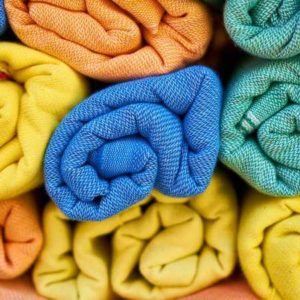In 2019, the German government introduced the Green Button. It is a government-run certification label for sustainably manufactured textiles in line with social and environmental criteria, placed on the market by companies committed to the fulfilment of their due diligence obligations. The government stipulates the requirements and conditions for the Green Button. The Green Button is awarded on behalf of the German Federal Ministry for Economic Cooperation and Development (BMZ).
The first iteration of the Green Button was unveiled in September 2019. At the time, 27 German brands and shops from diverse sectors were collaborating, including Vaude, Tchibo, and Hess Natur. After one year, the brand network has expanded to 52 enterprises, including Jack Wolfskin.
To be accepted for the Green Button, a certification label must not only fulfil the social and/or environmental criteria, but it must also be credible.
This means, for example, that the process by which the standard is decided must be open to the public, that (financial) structures must be transparent, and that frequent independent audits must be performed. The conditions for recognizing the label are outlined in the Green Button legislation.
During the introductory phase, the following credible labels can be used to demonstrate conformity with the social and environmental standards required for the Green Button:
Blauer Engel, Fairtrade, Fair Wear, Oeko-Tex Made in Green, Bluesign, Cradle-to-Cradle Silver, Global Organic Textile Standard (GOTS), Naturtextil IVN certified BEST, and SA 8000 are among the recognized seals/certification. The award of only one certification is designed to promote consumer clarity.
The Two Pillars of the Green Button Certification Label
1. Company audit
The company as a whole is required to demonstrate its social, environmental and human rights responsibility, on the basis of 20 criteria.
2. Product audit
Each product is required to comply with 26 social and environmental criteria, covering a wide spectrum from proper wastewater discharge to a ban on forced labour.
Download GREEN BUTTON-Standard 1.0
What companies are currently certified to use the Green Button for audited textiles?
What companies are currently certified to use the Green Button?
Despite the COVID-19 issue, which has impacted the textile industry particularly hard, the Green Button has already established itself in the market. More than 50 million textile items with the Green Button mark were sold in the first half of 2020, with 35 million of them being clothing. This equates to a market share of 1.5 to 3%, a commendable performance in the midst of the COVID-19 issue.
In the period since the Green Button was introduced in September 2019, 59 companies and their products have completed the process for using the mark, meaning that they comply with its ambitious social and environmental standards. You can find an up-to-date list here.
Does the Green Button apply to all products of a manufacturer or only individual products?
Does the Green Button apply to all products of a manufacturer or only individual products?
Each and every product must be audited. If a garment bears the Green Button, it satisfies all of the standards. Some businesses can already utilize the Green Button for their whole product line, while others can only utilize it for specific products. However, in every situation, the entire firm must work to improve its supply chain (the complete firm is always examined before any one product receives the Green Button, see ‘business audit’).
How and how often is a company audited to ensure compliance?
How often is a company audited to ensure compliance?
The company is re-audited every three years. During the intervening period, audits are carried out each year on a random basis. If there are any indications of irregularities, unannounced checks can be carried out, including at the production unit in the production country.
Don’t we have enough certification labels already?
Don’t we have enough certification labels already?
That is exactly the issue. Many individuals are just perplexed by the sheer number of various certification labels. Some labels advocate for better working conditions, while others advocate for the elimination of harmful chemicals. The Green Button provides direction. Textiles with the Green Button certification marking are produced in a socially and environmentally responsible manner that meets the highest requirements.








Your blog post is stunning. Thanks!!